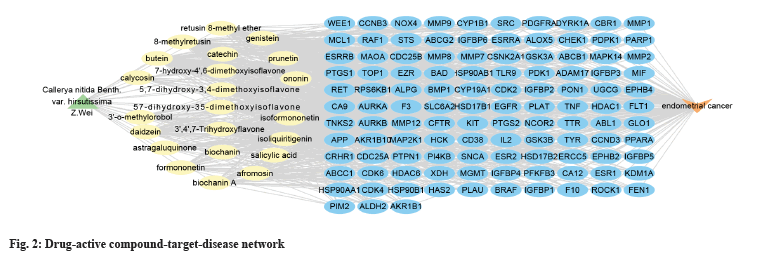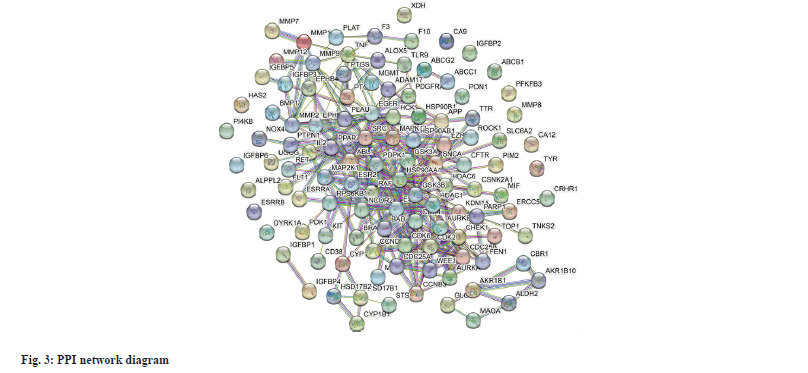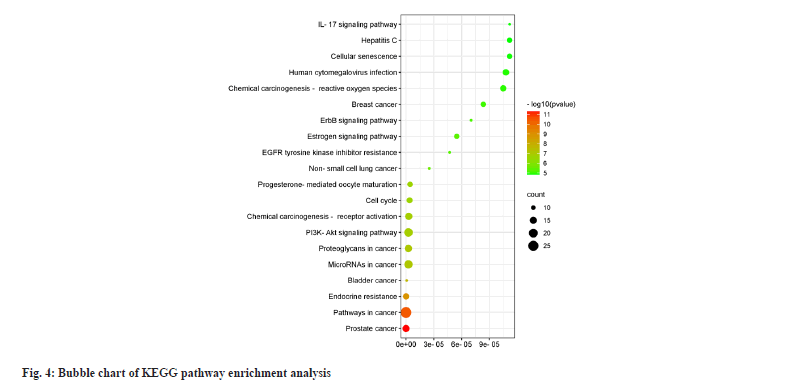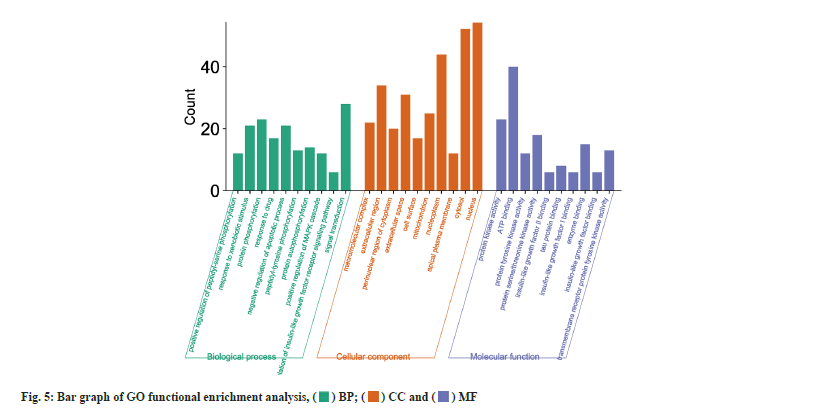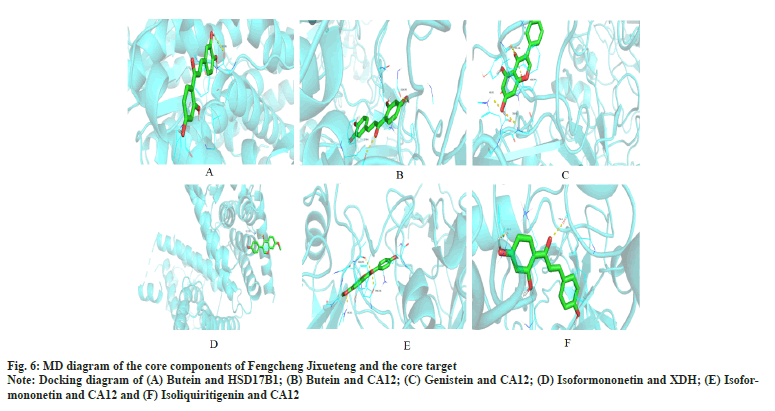- *Corresponding Author:
- Huifang Zhou
Infection Control Department, Affiliated Hospital of Youjiang Medical University for Nationalites, Baise, Youjiang, Guangxi 533000, China
E-mail: z1509191764@126.com
| This article was originally published in a special issue, “New Research Outcomes in Drug and Health Sciences” |
| Indian J Pharm Sci 2023:85(6) Spl Issue “175-183” |
This is an open access article distributed under the terms of the Creative Commons Attribution-NonCommercial-ShareAlike 3.0 License, which allows others to remix, tweak, and build upon the work non-commercially, as long as the author is credited and the new creations are licensed under the identical terms
Abstract
The main objective of this study was to explore the molecular targets and mechanisms of Callerya nitida Benth. var. hirsutissima Z. Wei in the treatment of endometrial cancer. The active components of Fengcheng Jixueteng and their corresponding gene targets and the gene targets corresponding to endometrial cancer diseases were screened out from relevant databases. On this basis, the protein-protein interaction network was constructed and the hub target was screened. Then we performed pathway enrichment analysis on targets and analyzed the binding energy of drugs and disease targets through molecular docking. Pathway enrichment analysis screened out pathways in cancer, phosphoinositide-3-kinase-protein kinase signaling pathway and other signaling pathways. The active ingredients such as butein, 3',4',7-trihydroxyflavone, isoformononetin, genistein, isoliquiritigenin play an important role in the targets like epidermal growth factor receptor, xanthine dehydrogenase, 17-beta-hydroxysteroid dehydrogenase 1, estrogen receptor 2 and carbonic anhydrase 12. Molecular docking results demonstrated that the active compounds of the drug such as butein, isoformononetin, genistein and isoliquiritigenin had good affinity with the disease targets such as 17-betahydroxysteroid dehydrogenase type 1, xanthine dehydrogenase and carbonic anhydrase 12 respectively (the binding energy was <-5 kJ/mol). The main active compounds of the Fengcheng Jixueteng can act on many disease targets. It participates in the regulation of multiple signaling pathways such as pathways in cancer and phosphoinositide-3-kinase/protein kinase signaling pathway to play an anti-endometrial cancer role.
Keywords
Network pharmacology, molecular docking, Callerya nitida Benth. var. hirsutissima Z. Wei, endometrial cancer
Endometrial Cancer (EC) is a malignant tumor originating from the endometrial epithelium[1]. The main symptoms of EC are vaginal bleeding and menstrual disorders, which are more common in perimenopausal and postmenopausal women[2]. The molecular pathogenesis of EC involves various genes and signaling pathway abnormalities such as microsatellite instability, tumor protein p53 gene mutation, abnormal Liver Kinase B1- Adenosine Monophosphate-activated Protein Kinase-mammalian Target of Rapamycin (LKB1- AMPK-mTOR) signaling pathway and abnormal Phosphoinositide-3-kinase-Protein kinase B-mTOR (PI3K-Akt-mTOR) signaling pathway, etc.[3-6] and many mechanisms remain unclear. At present, the commonly used drugs for the treatment of EC in Western medicine include hormone therapy, chemotherapy drugs and targeted drugs[7]. However, due to the multi-drug resistance and strong side effects of western medicine, the therapeutic effect of EC is limited. In recent years, with the discovery of more and more EC therapeutic targets, major breakthroughs have been made in targeted therapy. However, the current clinical application of targeted therapy in EC is not widespread and there are still many potential targets that have not been discovered. Therefore, the development of new natural compounds and the search for new EC therapeutic targets are current research hotspots.
Callerya nitida Benth. var. hirsutissima Z. Wei (Fengcheng Jixueteng in Chinese) is derived from the dried canes of legumes. It has the functions of invigorating blood, activating meridians and collaterals. It is mainly used for limb numbness, paralysis, waist and knee pain, irregular menstruation and anemia. Modern medicine shows that it has good anti-cancer and anti-viral activities[8]. At present, about 70 compounds have been isolated and identified in Fengcheng Jixueteng, which are mainly flavonoids, followed by triterpenoids and others contain lignin and phenolic acids[9]. Flavonoids have a variety of pharmacological activities. The anti-tumor mechanisms of flavonoids include, inhibiting tumor cell proliferation, promoting tumor cell apoptosis, interfering with cell signaling and regulating the relationship between tumor suppressor genes and oncogenes[10]. The current research was based on Network Pharmacology (NP) and Molecular Docking (MD) technology, which can predict the molecular targets and potential mechanisms of Fengcheng Jixueteng in the treatment of breast carcinoma[11]. Based on this study, it can be speculated that Fengcheng Jixueteng has the potential to become an EC therapeutic drug, but the target and molecular mechanism of Fengcheng Jixueteng as anti-EC are still unclear. Therefore, on the basis of previous scientific research achievements, this study intends to analyze for the first time, the mechanism of Fengcheng Jixueteng in the treatment of EC based on NP and MD technology. Based on the NP method, the targets and signal pathways of Fengcheng Jixueteng in the treatment of EC are studied. The MD technology was used to verify the binding force between components and targets. The significance of this study lies in preliminary research on the mechanism of action of Fengcheng Jixueteng on EC treatment and to provide a new way for EC treatment.
Materials and Methods
Screening the active compounds and related targets of Fengcheng Jixueteng:
Screening the active compounds of Fengcheng Jixueteng was done by mining literature and various databases. The active compounds in Fengcheng Jixueteng were retrieved using the Traditional Chinese Medicine Systems Pharmacology Database and Analysis Platform (TCMSP, https://old.tcmsp-e.com/tcmsp.php). Oral Bioavailability (OB)≥30 % and Drug-Likeness (DL)≥0.18 % were used as screening conditions. The Simplified Molecular Input Line Entry System (SMILES) number or two Dimensional (2D) structure of compounds obtained in the PubChem websites (https://pubchem.ncbi.nlm.nih.gov/) was put into the SwissTargetPrediction websites (http://www.swisstargetprediction.ch/), set the species to "Homo sapiens" and contained active ingredient targets with probability>0.1. In the TCMSP websites, the chemical composition-related target information of the Fengcheng Jixueteng was retrieved. The chemical composition-related target information of Fengcheng Jixueteng in the SwissTargetPrediction website and the TCMSP website were integrated. Finally, the drug targets were imported into the Universal Protein Resource (UniProt) website (https://www.uniprot.org) to query the standard gene names of proteins and finally a data set of Fengcheng Jixueteng target genes was obtained.
Screening of disease-related targets in EC:
In the GeneCards website (https://www.genecards.org/) and the Online Mendelian Inheritance in Man website (OMIM, https://www.omim.org/), we searched the relevant targets and gene sets of EC diseases with the keyword "Endometrial cancer".
Screening common targets for drugs and diseases:
Intersection analysis of Fengcheng Jixuetengrelated targets and EC disease-related targets was performed. The drug target dataset and disease target dataset were simultaneously imported into the online Venn analysis tool (http://bioinformatics.psb.ugent.be/webtools/Venn/) and finally the common drugdisease targets were obtained.
Construction of "drug-active compounds-targetsdiseases" network:
The "drug-active compounds-targets-diseases" network model was established by Cytoscape v3.9.1. The nodes in the network represent the drug (Fengcheng Jixueteng), potential active compound, disease (EC) and the common target, respectively. The edges represent the connection between drugsactive compounds-targets-diseases.
Construction of the network and core target screening of Fengcheng Jixueteng:
The intersection targets were imported into the Search Tool for the Retrieval of Interacting Genes/Proteins (STRING) websites (https://cn.string-db.org/) to create the Protein-Protein Interaction (PPI) Network. Adjust the highest confidence to >0.9 to remove independent genes. Export the Tab-Separated Values (TSV) file of the PPI relationship and finally obtain the PPI network diagram. The TSV file was put into Cytoscape v3.9.1 and the network analyzer function was used to screen out the top targets according to the degree value of the node.
Functional enrichment analysis:
The Database for Annotation, Visualization and Integrated Discovery (DAVID) websites (https://david.ncifcrf.gov/summary.jsp) was used to conduct Gene Ontology (GO) and Kyoto Encyclopedia of Genes and Genomes (KEGG) pathway enrichment analysis on the common targets of Fengcheng Jixueteng. According to the degree of enrichment and significance, the main 20 KEGG pathways were screened. In the results of GO functional analysis, the top 10 cell Biological Process (BP), Cellular Components (CC) and Molecular Functions (MF) with the largest number of genes and p<0.05 were screened according to the enriched result. Finally, the GO and KEGG results were visualized by bar graphs and bubble graphs through the bioinformatics website (http://www.bioinformatics.com.cn/).
MD study:
The 2D structures of the compounds were obtained from the PubChem websites, then converted to three Dimensional (3D) structures by Chem3D software and saved in MOL2 format. The compound in MOL2 format was imported into AutoDock Tools v1.5.7 and the operations of add atomic charge, assign atomic type and all flexible bonds can be rotated by default were performed on the compound and saved it in Protein Data Bank, Partial Charge (Q) and Atom Type (T) (PDBQT) format. The 3D structure Protein Data Bank (PDB) files of the core targets were downloaded from the PDB websites (http://www.rcsb.org/). The PDB file was imported into the PyMOL software and the commands remove solvent and remove organic were entered to remove water and ligands, saving it in PDB format. The core target PDB file after dewatering and deligation was imported into AutoDock Tools v1.5.7 and the nonpolar hydrogen addition operation and Gasteiger charge were calculated and it was saved in PDBQT format. MD analysis was performed using AutoDock Tools v1.5.7 and the docking results were visualized using PyMOL software. Molecular binding energy is used to assess the ability of a compound molecule to bind to a target. Binding energies<0 kJ/mol were considered spontaneous binding and binding energies≤-5 kJ/mol were considered well bound.
Results and Discussion
Active components and targets of Fengcheng Jixueteng were described here. By mining literature and various databases, a total of 62 active components of Fengcheng Jixueteng were preliminarily retrieved. 23 active ingredients of Fengcheng Jixueteng were finally obtained after screening from SwissTargetPrediction websites and TCMSP websites, merging and deduplication. However, one of them has no predicted target information, so it was deleted and 22 active ingredients were finally obtained, as shown in Table 1.
| Identifier (ID) | Chemical name | Molecular formula |
|---|---|---|
| FC1 | 5,7-dihydroxy-3′,4′-dimethoxyiso⁃flavone | C17H14O6 |
| FC2 | Prunetin | C16H12O5 |
| FC3 | Genistein | C15H10O5 |
| FC4 | Biochanin A | C16H12O5 |
| FC5 | 5,7-dihydroxy-3′,5′-dimethoxyisoflavone | C17H14O6 |
| FC6 | Ononin | C22H22O9 |
| FC7 | Isoformononetin | C16H12O4 |
| FC8 | Catechin | C15H14O6 |
| FC9 | Formononetin | C16H12O4 |
| FC10 | Calycosin | C16H12O5 |
| FC11 | 8-methylretusin | C17H14O5 |
| FC12 | Astragaluquinone | C17H16O6 |
| FC12 | Salicylic acid | C7H6O3 |
| FC14 | 3',4',7-Trihydroxyflavone | C15H10O5 |
| FC15 | Butein | C15H12O5 |
| FC16 | Isoliquiritigenin | C15H12O4 |
| FC17 | Retusin 8-methyl ether | C17H14O5 |
| FC18 | 7-hydroxy-4',6-dimethoxyisoflavone | C19H16O6 |
| FC19 | Biochanin | C16H12O5 |
| FC20 | Daidzein | C15H10O4 |
| FC21 | Afromosin | C17H14O5 |
| FC22 | 3'-O-methylorobol | C16H12O6 |
Table 1: Results of Fengcheng Jixueteng compound analysis
Intersection results of drug target datasets and disease target datasets were represented in fig. 1. A total of 165 targets related to active compounds of Fengcheng Jixueteng were collected from the SwissTargetPrediction websites and TCMSP websites. There are 4377 EC disease targets collected from GeneCards websites and OMIM websites. There are a total of 113 intersection targets in the two datasets. The 113 intersection targets were initially used as potential targets for the treatment of EC by Fengcheng Jixueteng.
Drug-ingredient-target-disease network construction was shown in fig. 2. There are a total of 1122 edges between 22 drug active ingredients and 113 disease targets in the network, in which the green triangle represents the Fengcheng Jixueteng, the blue circle represents the main active ingredient of Fengcheng Jixueteng and the yellow circle represents intersection target, as shown in fig. 2. List of 20 potential targets of Fengcheng Jixueteng against EC was shown in Table 2. The node degree value and proximity centrality degree reflect the core degree of nodes in the network. The degree value and betweenness centrality value were sorted by size to screen the top 5 core components and targets. The results showed that compounds such as butein, 3',4',7-trihydroxyflavone, isoformononetin, genistein, isoliquiritigenin and Epidermal Growth Factor Receptor (EGFR), Xanthine Dehydrogenase (XDH), 17-beta-Hydroxysteroid Dehydrogenase type 1 (HSD17B1) and targets such as Estrogen Receptor 2 (ESR2) and Carbonic Anhydrase 12 (CA12) were the core nodes of the network. These nodes may be the key compounds or targets for the treatment of EC by Fengcheng Jixueteng. The specific results are shown in Table 3.
| Serial number | Gene ID |
|---|---|
| 1 | MMP2 |
| 2 | ERCC5 |
| 3 | XDH |
| 4 | MMP7 |
| 5 | CDC25B |
| 6 | NCOR2 |
| 7 | CD38 |
| 8 | MAOA |
| 9 | CYP19A1 |
| 10 | TNKS2 |
| 11 | CA9 |
| 12 | IGFBP2 |
| 13 | SNCA |
| 14 | ESRRB |
| 15 | GSK3B |
| 16 | MMP1 |
| 17 | CA12 |
| 18 | CRHR1 |
| 19 | MMP8 |
| 20 | EGFR |
Table 2: Potential targets of Fengcheng Jixueteng against EC
| Name | Type | Degree | Betweenness centrality |
|---|---|---|---|
| Butein | mol | 96 | 0.174 |
| 3',4',7-trihydroxyflavone | mol | 95 | 0.17 |
| Isoformononetin | mol | 90 | 0.147 |
| Genistein | mol | 89 | 0.086 |
| Isoliquiritigenin | mol | 67 | 0.071 |
| EGFR | Target | 18 | 0.014 |
| XDH | Target | 17 | 0.011 |
| HSD17B1 | Target | 15 | 0.009 |
| ESR2 | Target | 13 | 0.008 |
| CA12 | Target | 12 | 0.007 |
Table 3: Key nodes of Drug-active ingredient-target-disease network
PPI network and core targets were shown in fig. 3. 113 intersecting targets were put into the STRING websites and the output was PPI network. There were 113 nodes and 167 edges involved in the PPI of Fengcheng Jixueteng in the treatment of EC, with an average degree of 2.96. The node degree was used as an evaluation parameter. The core target screening condition was set to a degree greater than 5.92 and a total of 21 targets were obtained. For example, Proto- Oncogene Tyrosine-Protein kinase Src (SRC), Heat Shock Protein 90-alpha member A1 (HSP90AA1), Estrogen Receptor 1 (ESR1) and Cyclin-Dependent Kinase 4 (CDK4) were the top 4 nodes with the largest correlation value. These 4 nodes may be potentially important targets for Fengcheng Jixueteng treatment of EC.
The functional enrichment analysis results showed a total of 111 related signaling pathways which were screened out by KEGG pathway enrichment (p<0.05) and the top 20 pathways with the smallest p value were selected. It is involved in multiple pathways, such as pathways in cancer, PI3K-Akt signaling pathway, micro Ribonucleic acids (miRNAs) in cancer, proteoglycans in cancer, prostate cancer, etc. as shown in fig. 4. In the GO analysis, there are 369 items for BP, 70 items for CC and 109 items for MF. The top 10 items of BP, CC and MF with the smallest ranking were screened out according to the significance of p<0.05. The main BPs involved includes signal transduction, protein phosphorylation and negative regulation of apoptotic process, etc. The main CCs involved include nucleus, cytosol and nucleoplasm, etc. The main MF involved includes, protein kinase activity, Adenosine Triphosphate (ATP) binding and protein serine/threonine kinase activity, etc. as shown in fig. 5. This indicates that Fengcheng Jixueteng affects EC cell apoptosis, protein phosphorylation and ATP binding through multiple signaling pathways.
MD results were explained here. In this study, MD of the core components was carried out. The results indicated that the binding energy of the core components of Fengcheng Jixueteng and the target protein was ≤-5 kJ/mol, their structure was stable and the binding activity was high. The binding energy of butein-HSD17B1 is -8.1 kJ/mol and the binding energy of butein-CA12 is -6.8 kJ/mol. The binding energy of genistein-CA12 is -9.5 kJ/mol and the binding energy of isoliquiritigenin-CA12 is -8.6 kJ/ mol. The binding energies of isoformononetin-XDH and isoformononetin-CA12 are -6.8 kJ/mol and -9.4 kJ/mol respectively, as shown in Table 4. Among them, 6 MD modes can be combined by hydrogen bonding, as shown in fig. 6.
| Compound | Target | PDB ID | Binding energy (kJ/mol) |
|---|---|---|---|
| Butein | HSD17B1 | 3km0 | -8.1 |
| CA12 | 7puw | -6.8 | |
| Genistein | CA12 | 7puw | -9.5 |
| Isoformononetin | XDH | 3osi | -6.8 |
| CA12 | 7puw | -9.4 | |
| Isoliquiritigenin | CA12 | 7puw | -8.6 |
Table 4: Binding energies of core compounds And core target Proteins of Fengcheng Jixueteng
EC is the fourth most familiar malignant tumor in females and the most familiar gynecological diseases in developed countries, which is mostly attributed to tumor metastasis[12,13]. Of these, type 1 (endometrioid carcinoma) was associated with a significant incidence of Catenin Beta 1 (CTNNB1), Kirsten Rat Sarcoma virus (KRAS) and Deoxyribonucleic Acid (DNA) Polymerase Epsilon (POLE) oncogene mutations. Type 2 (serous or clear cell carcinoma) associated with Tumor Protein 53 (TP53) mutation and Erythroblastic Oncogene B-2 (ERBB-2) overexpression[14]. The most commonly altered pathway in EC is the PI3K/ Akt/mTOR pathway, which can be used to regulate cell growth and survival. Dysregulation will result in the inactivation of Phosphatase and Tensin homolog (PTEN) or mutations in Phosphatidylinositol-4,5- bisphosphate 3-Kinase Catalytic subunit Alpha (PI3K3CA) and KRAS. Loss of PTEN expression is common in EC with good prognosis and PI3K3CA mutations are often associated with higher tumor grades. At present, clinically targeted drugs for EC are often divided into four categories. They are mTOR inhibitors, PI3K inhibitors, mTOR/PI3K dual inhibitors and Akt inhibitors[15]. It can effectively induce EC cell apoptosis and has achieved initial results in the treatment of advanced or recurrent EC[16]. At present, the research of Fengcheng Jixueteng is mainly concentrated in China. The research on the chemicals of Fengcheng Jixueteng is not perfect, the types of chemical components contained in Fengcheng Jixueteng is still limited and the research reports on its pharmacological activity are also few. Few researchers have extracted and isolated the flavonoids of Fengcheng Jixueteng, which mainly contains flavonoids, phenols, triterpenes and sterols and found that it has antitumor effect.
In this study, through the NP method, the compounds, core targets and pathways of Fengcheng Jixueteng in the treatment of EC were screened in the websites. MD technology was used to simulate its binding activity to elucidate the mechanism of Fengcheng Jixueteng in EC treatment. Finally, the main active ingredients contained in Fengcheng Jixueteng were butein, isoliquiritigenin, formononetin and so on. Many studies have indicated that butein inhibits EC cell viability and induces various tumor cell death via PI3K/Akt/mTOR and Extracellular signal- Regulated Kinase/p38 Mitogen-Activated Protein Kinase (ERK/p38 MAPK) pathways[17]. Studies have indicated that isoliquiritigenin has antioxidant, anti-inflammatory and antitumor effects, which can induce apoptosis, autophagy and inhibit the growth of EC in mice[18]. Isoliquiritigenin inhibits EC cell invasion and migration mainly by targeting the Transforming Growth Factor beta/Suppressor of Mothers against Decapentaplegic (TGF-β/SMAD) signaling pathway[19]. Formononetin can induce apoptosis in various cancer cells by acting on PI3K/ Akt/mTOR signaling pathway which is activated in a variety of malignant tumors[20]. It is suggested that these components may be the pharmacological basis for the treatment of EC by Fengcheng Jixueteng.
In this study, a "drug-active compound-targetdisease" network based on Fengcheng Jixueteng was constructed to screen the core targets such as HSD17B1, CA12 and XDH. HSD17B1 is controlled by estradiol, dihydrotestosterone and miRNAs and is regulated by cancer-related genes[21]. CA12 is a transmembrane enzyme involved in the regulation of extracellular pH and overexpression of CA12 can promote tumor growth and metastasis[22]. XDH is a valuable prognostic biomarker in a variety of cancers and it may play a role in tumor immunology[23].
The GO function and KEGG pathway enrichment analysis was carried out through the DAVID websites and a variety of signal transduction, protein phosphorylation, nucleus, cytosol, protein kinase activity and ATP binding biological pathways was involved in the GO function. Pathways in cancer, PI3K-Akt signaling pathway, microRNAs in cancer, proteoglycans in cancer, prostate cancer and other pathways are involved in KEGG enrichment analysis. This suggests that Fengcheng Jixueteng is involved in cancer-related pathways.
MD results indicated that the core effective compounds of Fengcheng Jixueteng are butein, isoliquiritigenin, isoformononetin, genistein and the core targets are HSD17B1, CA12 and XDH were all <-5 kJ/mol. The binding activity of the receptor protein was high, which fully verified the results obtained by NP.
In conclusion, this research used NP and MD technology for the first time to explore the pharmacodynamic components and mechanism of Fengcheng Jixueteng in the treatment of EC. The results showed that butein, isoliquiritigenin, isoformononetin, genistein and other components in Fengcheng Jixueteng may act on HSD17B1, CA12, XDH and other targets by playing a role in inhibiting apoptosis and anti-inflammatory. It shows that Fengcheng Jixueteng exerts its anti EC efficacy through multi-component, multi-target and multi-channel action, which provides ideas for further research on the treatment of EC in the future. However, this study has certain limitations, the data is used only for analysis and relevant experiments will be carried out to further verify the results of this research which may offer a basis for the growing of EC therapeutic drugs.
Conflict of interests:
The authors declared no conflict of interest.
References
- Yen TT, Wang TL, Fader AN, Shih IM, Gaillard S. Molecular classification and emerging targeted therapy in endometrial cancer. Int J Gynecol Pathol 2020;39(1):26-35.
[Crossref] [Google scholar] [PubMed]
- Urick ME, Bell DW. Clinical actionability of molecular targets in endometrial cancer. Nat Rev Cancer 2019;19(9):510-21.
[Crossref] [Google scholar] [PubMed]
- Evrard C, Alexandre J. Predictive and prognostic value of microsatellite instability in gynecologic cancer (endometrial and ovarian). Cancers 2021;13(10):1-15.
[Crossref] [Google scholar] [PubMed]
- Nakamura M, Obata T, Daikoku T, Fujiwara H. The association and significance of p53 in gynecologic cancers: The potential of targeted therapy. Int J Mol Sci 2019;20(21):1-16.
[Crossref] [Google scholar] [PubMed]
- Yin X, Liu Y, Qin J, Wu Y, Huang J, Zhao Q, et al. Artesunate suppresses the proliferation and development of estrogen receptor-a-positive endometrial cancer in HAND2-dependent pathway. Front Cell Dev Biol 2021;8:1-14.
[Crossref] [Google scholar] [PubMed]
- Roncolato F, Lindemann K, Willson ML, Martyn J, Mileshkin L. PI3K/AKT/mTOR inhibitors for advanced or recurrent endometrial cancer. Cochrane Database Syst Rev 2019;10(10):CD012160.
[Crossref] [Google scholar] [PubMed]
- Post CC, Westermann AM, Bosse T, Creutzberg CL, Kroep JR. PARP and PD-1/PD-L1 checkpoint inhibition in recurrent or metastatic endometrial cancer. Crit Rev Oncol Hematol 2020;152:102973.
[Crossref] [Google scholar] [PubMed]
- Zhang L, Rao ZJ, Guan YY, Zhang HM. Investigation of determining strontium in M. nitidaBenth. var. hirsutissima Z. Wei. by flame atomic absorption spectra. Guang Pu Xue Yu Guang Pu Fen Xi 2010;30(12):3421-4.
[Crossref] [Google scholar] [PubMed]
- Jin C, Huang H, He Y, Zhang L. Chemical constituents from the stem of Callerya nitida Benth. var. hirsutissima Z. Wei. J China Pharm Univ 2021;52(2):177-85.
- Liu Z, Fu YZ. Study on in vitro antitumor effect of H-103 resin purified from Callerya nitida Benth. var. hirsutissima Z. Wei. Lishizhen Med Mater Med Res 2010;21(6):1537-9.
- Li XX, Jin C, Chen K, Cheng YY, Zhang QX, Tian XD, et al. Mechanism of Callerya nitida. var. hirsutissima in treatment of breast cancer based on network pharmacology. Chin Pharmacol Bull 2022;38(5):767-75.
- di Tucci C, Capone C, Galati G, Iacobelli V, Schiavi MC, di Donato V, et al. Immunotherapy in endometrial cancer: New scenarios on the horizon. J Gynecol Oncol 2019;30(3):e46.
[Crossref] [Google scholar] [PubMed]
- Passarello K, Kurian S, Villanueva V. Endometrial cancer: An overview of pathophysiology, management and care. Semin Oncol Nurs 2019;35(2):157-65.
[Crossref] [Google scholar] [PubMed]
- Terzic M, Aimagambetova G, Kunz J, Bapayeva G, Aitbayeva B, Terzic S, et al. Molecular basis of endometriosis and endometrial cancer: Current knowledge and future perspectives. Int J Mol Sci 2021;22(17):1-24.
[Crossref] [Google scholar] [PubMed]
- van den Heerik AS, Horeweg N, de Boer SM, Bosse T, Creutzberg CL. Adjuvant therapy for endometrial cancer in the era of molecular classification: Radiotherapy, chemoradiation and novel targets for therapy. Int J Gynecol Cancer 2021;31(4):594-604.
[Crossref] [Google scholar] [PubMed]
- Shu T, Bai P. Research progress of PI3K/Akt/mTOR signaling pathway in targeted therapy of advanced or recurrent endometrial cancer. Oncol Prog 2014;12(5):457-63.
- Yang PY, Hu DN, Kao YH, Lin I, Liu FS. Butein induces apoptotic cell death of human cervical cancer cells. Oncol Lett 2018;16(5):6615-23.
[Crossref] [Google scholar] [PubMed]
- Wu CH, Chen HY, Wang CW, Shieh TM, Huang TC, Lin LC, et al. Isoliquiritigenin induces apoptosis and autophagy and inhibits endometrial cancer growth in mice. Oncotarget 2016;7(45):73432-47.
[Crossref] [Google scholar] [PubMed]
- Chen HY, Chiang YF, Huang JS, Huang TC, Shih YH, Wang KL, et al. Isoliquiritigenin reverses epithelial-mesenchymal transition through modulation of the tgf-ß/smad signaling pathway in endometrial cancer. Cancers 2021;13(6):1-20.
[Crossref] [Google scholar] [PubMed]
- Zhao Y, Feng Y, Zhang L, Yu C. Research progress on anti-tumor mechanism of formononetin. Chin J Exp Tradit Med Formul 2021;27(10):193-203.
- Hilborn E, Stål O, Alexeyenko A, Jansson A. The regulation of hydroxysteroid 17ß-dehydrogenase type 1 and 2 gene expression in breast cancer cell lines by estradiol, dihydrotestosterone, microRNAs, and genes related to breast cancer. Oncotarget 2017;8(37):62183-94.
[Crossref] [Google scholar] [PubMed]
- Graham N, Pollard JW. An acid trip activates protumoral macrophages to promote hepatocellular carcinoma malignancy. J Clin Invest 2022;132(7):e158562.
[Crossref] [Google scholar] [PubMed]
- Lin Z, Xie YZ, Zhao MC, Hou PP, Tang J, Chen GL. Xanthine dehydrogenase as a prognostic biomarker related to tumor immunology in hepatocellular carcinoma. Cancer Cell Int 2021;21(1):1-14.
[Crossref] [Google scholar] [PubMed]

